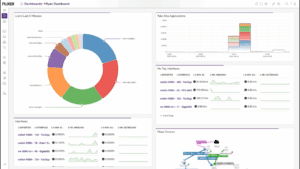Encryption protects data privacy, but it also hides intent. Every day, more of the world’s network traffic moves under TLS or HTTPS. That’s good for users, but it leaves analysts struggling to understand what their networks are actually doing. When every packet looks the same, even the best SIEM or endpoint detection platform loses context.
You can still see connections, but not motives. Thousands of HTTPS sessions might be completely benign… or one might hide command-and-control activity or data exfiltration. Without visibility inside encrypted flows, the question shifts from what happened? to how can we prove it?
Plixer FlowPro, part of the Plixer One platform, helps teams answer that question. Instead of trying to decrypt traffic, it turns to the one protocol that still speaks in the open: DNS. By analyzing DNS behavior, FlowPro extracts the intent behind encrypted connections and turns that data into actionable network evidence.
Why DNS Holds the Key to Encrypted Visibility
Every connection, whether safe or malicious, begins with a DNS query. Attackers can’t hide from that step. They might use temporary domains or encode commands in TXT records, but their behavior leaves a trail.
DNS data reveals much more than destinations. It exposes how a device behaves: how often it queries a domain, how long a name exists before it’s dropped, and how many failed lookups occur before success. Each of these patterns can point to command-and-control channels, tunneling, or botnet activity.
FlowPro uses that information to fill the visibility gap that encryption leaves behind. It collects mirrored network traffic, inspects DNS packets, and exports enriched flow records that describe what’s really happening. Those records give analysts a factual narrative that complements data from their SIEM or EDR tools.
How FlowPro Collects and Processes DNS Data
FlowPro deploys as a physical or virtual probe at key observation points in the network. Each probe operates passively; it watches mirrored traffic without touching the original packets. There’s no decryption, interception, or endpoint agent.
The probe performs deep-packet inspection on DNS transactions and extracts metadata such as:
- The full query and response
- JA3 and TLS fingerprints of encrypted sessions
- Domain reputation scores from trusted threat-intelligence feeds
- NXDOMAIN frequency and TXT-record anomalies
- Source and destination relationships between hosts
The resulting records are exported in IPFIX format to the Plixer One collector, where its analytics engine performs correlation and analysis. This structure allows FlowPro to scale easily, providing consistent visibility across data centers, branches, and cloud environments.
Why Passive Collection Matters
Other visibility tools often depend on endpoint agents or SSL interceptors. Those methods can slow performance, create privacy concerns, and require ongoing certificate management.
FlowPro avoids those challenges. By using mirrored traffic and open standards, it delivers deep visibility without modifying the environment. It’s a practical approach for enterprises that can’t deploy agents on every device or decrypt every packet.
Because FlowPro enriches the flow data you already collect, it fits into existing infrastructure. With no additional overhead, you get cleaner, more complete context for every connection.
From DNS Anomalies to Actionable Intelligence
Once FlowPro exports enriched DNS data, Plixer One takes over correlation and visualization. A typical workflow looks like this:
- Detection: FlowPro identifies unusual DNS behavior, such as repeated lookups to newly registered domains, or a host generating a high number of failed queries
- Reputation Check: Each domain is scored using reputation feeds and Plixer’s threat-intelligence lists
- Correlation: Plixer One links the DNS event to related hosts, applications, and conversations
- Validation: Analysts review the timeline to determine whether the pattern represents normal activity or a real incident
- Documentation: Once validated, the event is captured as a SIEM or EDR ticket with a complete investigation path and supporting evidence
This process replaces guesswork with verifiable facts. Analysts no longer debate whether an alert “might” be malicious. Instead, they can show exactly what happened, when it occurred, and which systems were involved.
What DNS Enrichment Adds to the SIEM
For most SIEMs, an outbound HTTPS session is just a pair of IP addresses and ports. When enriched with DNS data from FlowPro, that same session becomes explainable.
Instead of an anonymous connection, analysts see:
- Queried domain (e.g.,
login-verify-sync[.]com) - Reputation (e.g., “High risk, recently registered”)
- TLS fingerprint (e.g., “Known command-and-control pattern”)
- NXDOMAIN ratio (e.g., “40% [consistent with beaconing]”)
- Affected hosts (e.g.,
ENG-laptop-03,Finance-GW-02)
That single record transforms a generic connection into a detailed story of intent. It tells the analyst what the domain is, who contacted it, and why it matters.
By integrating directly with the SIEM, FlowPro enables correlation rules that look beyond IPs and ports. It gives analysts a way to focus on high-confidence events and ignore background noise.
Validation and Evidence
Speed matters, but credibility matters more. Every FlowPro detection includes the information needed to prove an analyst’s conclusion.
Each investigation generates a timeline that shows:
- When the DNS event began
- Which hosts and applications were involved
- What responses the DNS server provided
- Whether traffic followed those responses
Analysts can export this timeline as a ticket inside their SIEM or case-management system. The resulting artifact includes conversation paths, fingerprints, and correlated entities.
That artifact becomes defensible evidence. It can support an audit, a compliance review, or a post-incident report. It’s the difference between saying “we think it’s contained” and demonstrating how it was contained.
Benefits for Both Security and Network Teams
Although FlowPro was designed for security operations, its data benefits network operations as well. DNS failures or latency spikes can reveal misconfigured services and routing issues.
A single dataset now supports two outcomes:
- For SecOps: Confirm which alerts are real, eliminate false positives, and track incident scope
- For NetOps: Diagnose performance degradation, forecast capacity, and validate configuration changes
Because both teams rely on the same timeline and evidence, collaboration becomes faster and more objective. There’s no need for duplicate investigations or competing dashboards.
Deployment and Scalability
FlowPro is available as a rack-mountable appliance or as a virtual machine for VMware ESXi, Microsoft Hyper-V, and KVM environments. Each deployment can monitor gigabit or multi-gigabit interfaces, and additional probes can be registered automatically with Plixer One through secure APIs.
Default configurations include open-source intrusion-detection rules that can be customized to match organizational policy.
Whether deployed in a single data center or across dozens of remote sites, FlowPro maintains the same operational model: collect traffic, enrich DNS and flow data, export standardized evidence.
Because it uses IPFIX, the enriched data can feed multiple tools simultaneously: Plixer One for analytics, your SIEM for correlation, and your data lake for long-term modeling.
Why DNS-Based Analytics Are Essential
Network encryption isn’t going away. TLS 1.3, QUIC, and encrypted DNS are designed to hide content.
By focusing on metadata and behavior rather than payloads, FlowPro offers continuous insight without compromising user privacy or system performance.
DNS analytics bridge the gap between visibility and compliance. They let organizations understand intent, confirm security posture, and maintain observability even as encryption adoption grows.
Want to see how FlowPro reveals DNS-based threats your SIEM can’t detect alone? Schedule a short demo with one of our engineers today.



